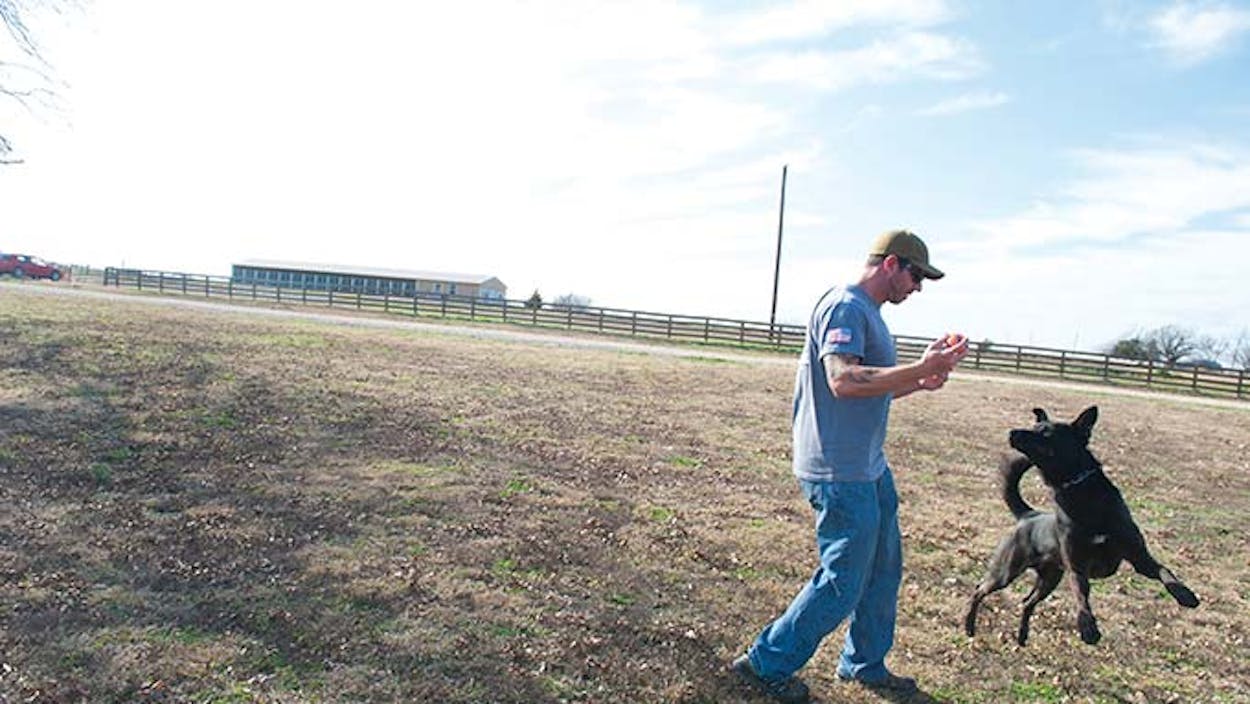In the farm country just outside Commerce, the front door of a red-brick-and-limestone house opens and a stout dog with a black face and pricked ears emerges. Its wide, shining eyes are fixed on a 22-year-old man wearing a thick black suit of padded, densely handwoven linen. Matt Davis squares his shoulders and glares at Tigo, a Dutch shepherd. Tigo’s trainer, former Navy SEAL Mike Ritland, grips his leash and finally says the Dutch command—Ritland does not want it printed in these pages—that every tendon in the dog’s body is quivering to hear.
Davis sneers at the streak of black charging across the yard, crouches, and seconds later absorbs all seventy pounds of the angry dog, which hangs from his bicep by a set of canines and molars that will mottle his arm black and blue despite the protective gear. For the next few minutes, Davis hoists Tigo, places him in headlocks, and slaps him in the ribs. The dog won’t let go.
When it’s time to end this exercise, Ritland doesn’t yank Tigo’s leash or bark a command. Instead, he gently strokes Tigo’s back and says another command—an abbreviation of the Dutch word for “let go.” And, as if a switch has been flipped, the dog does just that.
Tigo is a pupil here at Trikos International, the kennel where Ritland trains K9’s for federal law enforcement and the Department of Defense, as well as for personal protection, usually in the service of “high net worth individuals.” As he explains in his new book, Team Dog: How to Train Your Dog—the Navy SEAL Way, Ritland spent twelve years as a SEAL, sometimes working with dogs, before retiring in 2009 and starting up his own business. Most of the dogs he trains are Belgian Malinois. “They’re the Michael Jordans, the Kobe Bryants,” he says of his animals. “They’re freaks.” When he finds the right dog and subjects it to his training regimen, it will be capable of sniffing out a few molecules of explosive from an IED or an enemy waiting hundreds of yards away in ambush. It will apprehend and subdue combatants, who sometimes lose consciousness from shock as a dense mass of thrashing muscle anchors itself gums-deep into their flesh. One overeager Malinois broke Ritland’s wrist.
Taking up just as much of Trikos’s kennel space are the retirees—dogs that were shot or caught in an explosion, suffer from post-traumatic stress disorder, or simply grew old. Some of them get adopted, like Carlos, a Malinois who will live out his golden years in Tampa, Florida. Some come back too wired by the things that they’ve endured to live with a new family. So they stay with Ritland on his twenty acres, surrounded by hay bales and green fields and provided for with the help of his Warrior Dog Foundation. Ritland plays fetch with them and watches as the long, lean animals sprint low across the pasture and dive after tennis balls with the sort of over-the-top zeal they’re bred for. They’d chase the ball until their hips gave out if he’d let them.
In a way, Ritland is just like his dogs. In 2005, while deployed in Iraq, he came down with a fungal lung infection from the blowing dust. The barrel-chested, heavily muscled soldier dropped to 140 pounds before he shook off the infection. He could no longer perform as a SEAL, the only thing he’d ever wanted to be. He had run up against the limits of his flesh. But like his canine charges, he found a way to keep going. “These dogs get PTSD, they get injured,” he says. “But that drive will always exist in them, the same way it does in me.”







